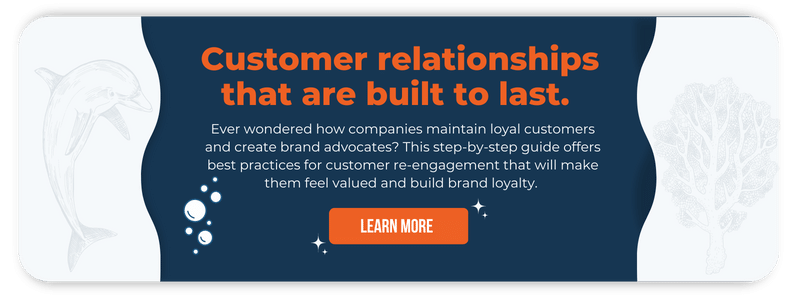Are You Re-engaging with Your Customers? Here’s Why You Should
Emily Buchan

What happens after you lose touch with a customer or that perfect lead who ghosted you? You might think a lost customer is — well, lost, but you have another option: re-engagement!
Re-engaging customers or leads who almost sealed the deal is a great way to generate business from your current contact database. And, because you already know what those contacts were looking for, you know exactly what to focus on in your re-engagement.
Why You Should Re-engage with Customers
You know that acquiring new customers is five times more expensive than retaining your existing ones. But did you also know that:
- Your current customers are 50% more likely to try your new products
- Current customers spend 31% more than new customers
Re-engagement isn’t just about money — often, customers make their purchase and stop hearing from the company they purchased with. Especially with complex products and services, like those in B2B, it’s essential to keep in touch with your customers and foster that relationship you worked so hard to build.
This stage of the buyer’s journey, customer delight, is critical to the difference between happy customers who buy from you again and leave positive reviews and those who end their subscription and move on. In HubSpot’s flywheel model, delight is a way to remove friction by ensuring customers are happy and add force by driving upsells and creating promoters.
Re-engaging customers and lost leads isn’t necessarily a quick-win strategy. But customers who come on board and stay on board are happier, more loyal clients who ultimately have a higher lifetime value.
3 Types of Re-engagement Campaigns
Reaching out via email is a great way to start if you’re looking to re-engage inactive customers and lost leads. Here are just a few of the email strategies you could try:
- Feedback survey: The right survey requires minimal effort from the customer but can also offer insight into why they’ve become unengaged with your company. Try an NPS survey, for example.
- Personalized offer: Use what you know about their purchase history to offer a personalized incentive, upgrade, discount, or bundle.
- Ask them to update their email preferences: We all know we can unsubscribe at any time, but how many of us actually do? Remind inactive customers they can unsubscribe from certain types of emails if they don’t find them helpful, meaning they receive more of the content they want from you.
There are plenty of other ways to re-engage with your customers, so spend some time brainstorming about what might be unique for your business to reconnect!
How Personalization Improves Your Re-engagement Strategies
When considering a re-engagement strategy, personalization is critical. After all, this is someone you’ve formed a relationship with — you know what the customer purchased or was considering and the unique aspects and challenges of their business. Sending a simple “what’s up” email isn’t going to cut it.
Personalizing content in a re-engagement strategy lets the customer know you remember them and what problem they were trying to solve. Use personalization when sending re-engagement emails to:
- Recommend products or add-ons
- Offer an incentive
- Recommend support content
Personalizing Content with Your CRM
Ideally, if you use a CRM, all your customers’ information is stored neatly together. You should at least be able to track down what your customers bought, but depending on the depth of your CRM, you could find much more, like:
- Specific questions they asked via chat, email, or phone call
- Blog content and pages they’ve visited on your website
- Premium content they’ve downloaded
- Forms they submitted
- Social posts they’ve interacted with
The more information you have, the easier it is to reconnect and recommend what’s next for their relationship with your business. In a CRM like HubSpot, you may even be able to see if a customer has been on your website recently, which could indicate they need help or are considering another purchase.
Need help with scrubbing or implementing your HubSpot CRM? We got you.
Measuring Re-engagement Campaign Effectiveness
No marketing initiative is complete without measuring your results. Here are some metrics to look at when measuring a re-engagement email campaign:
- Email opens
- Link clicks
- Meetings, demos, or calls scheduled
- New deals created from existing contacts
- Change in number of active contacts
Adjust your campaign accordingly to improve results. For example, if contacts are opening your emails but not clicking the links, adjust the email content or check the subject line and content for any disconnect. Is there a promise in your subject line not fulfilled by the email content?
Consider the bounce rate of the pages linked in your email, too. If you link to a knowledge base article, but the bounce rate is still reasonably high, customers may not find that article useful. Consider using a different piece, or tweak the one you’re using to provide better support.
What Does Customer Re-engagement Mean for Your Business?
Re-engagement is a powerful tool for your business that can drive upsells, increase customer loyalty and satisfaction, and increase customer lifetime value. Take a deep dive into developing your customer re-engagement strategy with our guide: Loyalty Re-engagement Strategy. Learn how to:
- Contact management for customer retention
- Segmentation best practices
- Personalization and retargeting for re-engagement


